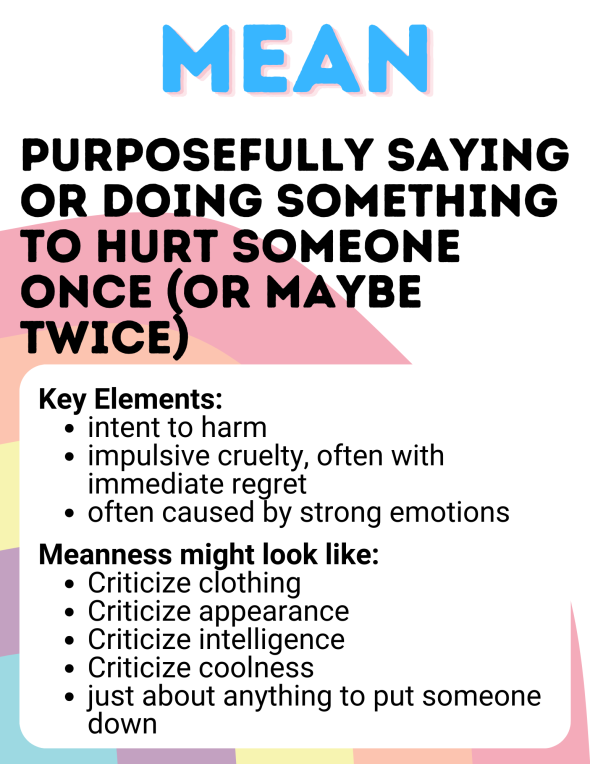Introduction
Ulloa takes reports of harassment and bullying seriously. Please contact the classroom teacher and admin team for any concerns around harassment and/or bullying.
SFUSD Definition of Bullying
Bullying is defined as any severe or pervasive physical or verbal act(s) or conduct, including electronic communications committed by a pupil(s) that has, or can be reasonably predicted to have, the effect of one or more of the following:
-
Reasonable fear of harm to person or property.
-
Substantially detrimental effect on physical or mental health.
-
Substantial interference with academic performance.
-
Substantial interference with the ability to participate in or benefit from school services, activities, or privileges.

Rude = Inadvertently saying or doing something that hurts someone else.
Rudeness might look like:
- burping in someone’s face
- jumping ahead in line
- bragging about achieving the highest grade
- throwing a crushed up pile of leaves in someone’s face
Incidents of rudeness are usually:
- Spontaneous
- Unplanned Inconsideration
- Based on Thoughtlessness
- Poor Manners
- Narcissism
but not meant to actually hurt someone.

Mean = Purposefully saying or doing something to hurt someone once (or maybe twice)
The main distinction between “rude” and “mean” behavior has to do with intention; while rudeness is often unintentional, mean behavior very much aims to hurt or depreciate someone.
Meanness might look like:
- Criticize clothing
- Criticize appearance
- Criticize intelligence
- Criticize coolness
- just about anything else they can find to denigrate
Meanness also sounds like words spoken in anger—impulsive cruelty that is often regretted in short order. Very often, mean behavior in kids is motivated by angry feel

Bullying = Intentionally aggressive behavior, repeated over time, that involves an imbalance of power.
Experts agree that bullying entails three key elements:
- an intent to harm
- a power imbalance
- repeated acts or threats of aggressive behavior
Kids who bully say or do something intentionally hurtful to others and they keep doing it, with no sense of regret or remorse—even when targets of bullying show or express their hurt or tell the aggressors to stop.
More Information About Bullying Link to this section
Bullying may be physical, verbal, relational, or carried out via technology:
- Physical aggression was once the gold standard of bullying—the “sticks and stones” that made adults in charge stand up and take notice.
- Examples:
- Hitting
- Punching
- Kicking
- Spitting
- Tripping
- Hair-pulling
- slamming a child into a locker
- Examples:
- Verbal aggression is what our parents used to advise us to “just ignore.” We now know that despite the old adage, words and threats can, indeed, hurt and can even cause profound, lasting harm.
- Relational aggression is a form of bullying in which kids use their friendship—or the threat of taking their friendship away—to hurt someone.
- Examples:
- Social exclusion
- Shunning
- Hazing
- Rumor spreading
- It can be especially beguiling and crushing to kids.
- Examples:
- Cyberbullying is a specific form of bullying that involves technology.
- “willful and repeated harm inflicted through the use of computers, cell phones, and other electronic devices.
- likelihood of repeated harm is especially high with cyberbullying because electronic messages can be accessed by multiple parties, resulting in repeated exposure and repeated harm.
Source: Is It Rude, Is It Mean, Or Is It Bullying?
This page was last updated on November 14, 2023

